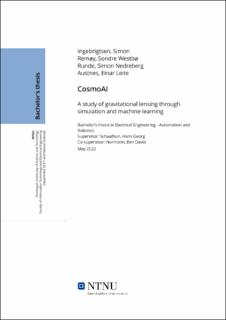| dc.contributor.advisor | Schaathun, Hans Georg | |
| dc.contributor.advisor | Normann, Ben David | |
| dc.contributor.author | Ingebrigtsen, Simon | |
| dc.contributor.author | Remøy, Sondre Westbø | |
| dc.contributor.author | Runde, Simon Nedreberg | |
| dc.contributor.author | Austnes, Einar Leite | |
| dc.date.accessioned | 2022-07-07T17:20:52Z | |
| dc.date.available | 2022-07-07T17:20:52Z | |
| dc.date.issued | 2022 | |
| dc.identifier | no.ntnu:inspera:110437709:110437910 | |
| dc.identifier.uri | https://hdl.handle.net/11250/3003634 | |
| dc.description.abstract | Gravitasjonslinsing brukes som et verktøy for å lokalisere og kartlegge mørk materie i universet.
Gjennom Roulette-formalismen håper man at informasjon i linsen kan tolkes ved hjelp av ett felles matematisk rammeverk. Metoden for å hente ut informasjon fra linsen kan effektiviseres og gjøres mer nøyaktig ved bruk av maskinlæring. Dersom man knekker maskinlæringsproblemet kan det forårsake et paradigmeskifte innen kartleggingen av mørk materie. Det finnes i dag verktøy som er i stand til å generere de store datasettene som er nødvendig for å trene en maskinlæringsmodell, men disse har ikke åpen kildekode, ei heller i stand til å simulere Roulette-formalismen. I denne avhandling har vi utviklet en simulator med åpen kildekode som er i stand til å generere hundretusenvis av syntetiske bilder. Simulatoren har også blitt implementert som en applikasjon med et brukervennlig grensesnitt. Installasjonen av applikasjonen er enkel og krever ingen erfaring med programmering for å bruke. Store datasett med forvrengte bilder, hvor hvert bilde har tilfeldige linseparameterne, ble brukt for å trene et nevralt nettverk til å identifisere disse parameterne. Flere nettverks-arkitekturer ble testet, men en modifisert av AlexNet pekte seg ut som mest egnet. Nettverket var i stand til å estimere linseparameterne i alle valideringsbildene med høy nøyaktighet. | |
| dc.description.abstract | Gravitational lensing serves as a tool for locating and mapping dark matter across the universe. Through the Roulette formalism it is hoped that the information hidden in the lenses can be deciphered with a common mathematical framework. The process of unveiling the lens' information could be more efficient and accurate through the use of machine learning. Cracking the machine learning problem could cause a paradigm shift in how we map dark matter. Tools capable of producing the large sets of data that is needed to train a machine learning model exist, however, these are not open source, nor able to simulate the Roulette formalism. In this thesis we have created an open source simulator able to produce these datasets of both traditional gravitational lensing and Roulette, in large quantities. This simulator enables the creation of hundreds of thousands of synthetic images. The simulator has also been made into an application with a user friendly interface. The application is easy to install and require no prior experience with programming to set up and use. Large datasets of distorted images with random lensing parameters were used for training a neural network with the goal of identifying the parameters. Several network architectures were tested, but a modified version of the AlexNet stood out as the most suited. The network was able to accurately predict the lens' parameters in all of the validation images. | |
| dc.language | eng | |
| dc.publisher | NTNU | |
| dc.title | CosmoAI: A study of gravitational lensing through simulation and machine learning | |
| dc.type | Bachelor thesis | |
